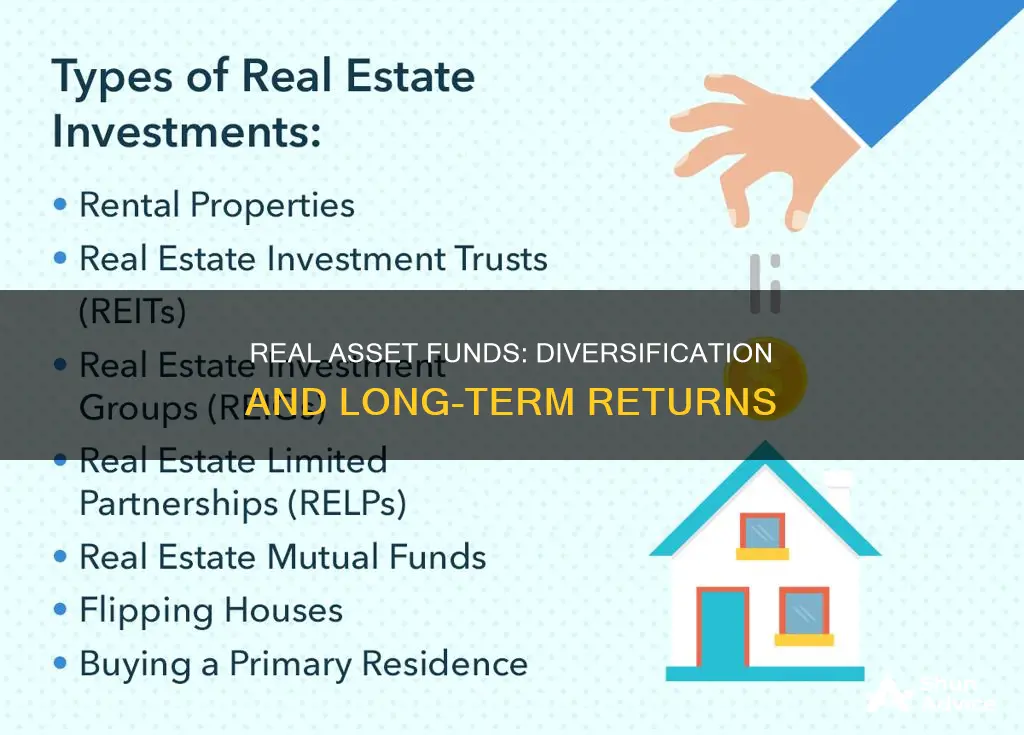
Real assets are a type of investment that covers physical assets such as real estate, energy, and infrastructure. They are appealing to investors for several reasons, including high current income, inflation protection, low correlation to equity markets, and favourable tax treatment. Real assets have an intrinsic value derived from their physical qualities, and they are particularly well-suited for investment during inflationary times. They also provide portfolio diversification as they often move in the opposite direction to financial assets like stocks or bonds. In addition, real assets have historically had low correlations with other types of real assets, making them a good option for diversifying one's portfolio.
| Characteristics | Values |
|---|---|
| Diversification | Real assets can help diversify an investment portfolio, as they have a low correlation with financial assets like stocks and bonds. |
| Inflation hedge | Real assets tend to increase in value during inflationary periods, making them a good hedge against inflation. |
| Competitive returns | Real assets can generate consistent income streams and may outperform during periods of high nominal economic growth. |
| Stability | Real assets are less susceptible to macroeconomic factors such as inflation, currency exchange fluctuations, and other economic shifts. |
| Long-term value | The intrinsic value of real assets may increase due to higher utilisation, greater demand, or scarcity of supply. |
| Income generation | Real assets can provide stable and predictable income streams, making them attractive for investors seeking regular cash flow. |
| Global exposure | Real asset investments provide exposure to global economic and population growth, allowing investors to capitalise on international opportunities. |
What You'll Learn

Real assets are a good inflation hedge
The price of real assets tends to increase with inflation, as they can pass on higher prices to consumers. This allows investors to keep pace with inflation and protect their purchasing power. Real assets are also scarce by nature, as they are physical assets with a finite supply. As global demand increases, their value tends to rise, leading to substantial monetary gains for investors.
Additionally, real assets often generate stable cash flow for investors, making them attractive for those seeking predictable income streams. The income generated from leasing or operating real assets can be hedged against rising prices, further protecting investors from inflation.
Real assets have historically outperformed global equities and bonds during periods of high and rising inflation. Commodities, which make up a large portion of the CPI (the index used to measure inflation), are positively correlated with inflation. Similarly, farmland, which produces these commodities, has traditionally held a strong correlation with the CPI.
Overall, real assets provide a good hedge against inflation due to their intrinsic value, scarcity, ability to generate stable cash flow, and positive correlation with inflationary measures.
Vanguard Mutual Funds: Are They Worth the Investment?
You may want to see also

They offer portfolio diversification
Real asset funds offer portfolio diversification because they are physical assets with intrinsic worth due to their substance and properties. They are appropriate for inclusion in most diversified portfolios because of their relatively low correlation with financial assets, such as stocks and bonds. Real assets often move in opposite directions to financial assets, which means they can help to minimise losses during market downturns.
Real assets include precious metals, commodities, real estate, land, equipment, and natural resources. They are a separate and distinct asset class from financial assets. Financial assets derive their value from a contractual claim on an underlying asset that may be real or intangible. For example, commodities and property are real assets, but commodity futures, exchange-traded funds (ETFs), and real estate investment trusts (REITs) are financial assets.
Real assets have a direct link to hard assets, which means they often store long-term value better than more traditional investments. Their intrinsic value may also increase due to higher utilisation, greater demand, or scarcity of supply. Real assets are also less susceptible to macroeconomic factors such as inflation, shifts in currency values, and other economic downturns.
The efficient market hypothesis would indicate that the private markets that real assets are often traded on, such as real estate or farmland, offer greater potential returns than the more liquid financial assets.
Artificial Intelligence: Mutual Funds for Future Tech Investors
You may want to see also

They are a source of stable income
Real asset funds are a source of stable income. Real assets are physical assets that have an intrinsic worth derived from their substance and properties. They include precious metals, commodities, real estate, land, equipment, and natural resources. These assets have a tangible form, and their value comes from their physical qualities.
Real assets often generate significant and stable cash flow for investors, making them ideal for institutional investors and individuals approaching or in retirement. This stable income, combined with price appreciation, is a highly desirable trait for investments. Real assets such as real estate, infrastructure, and farmland produce stable and increasing income streams that are predictable and easy to manage.
For example, people need places to live and work, and businesses need office space. Similarly, farmland produces food, an essential commodity. This stable demand for real assets provides investors with a predictable income stream and value appreciation. Real assets are also a good source of long-term passive income. The location, class, and use of real assets determine the yield and potential operating income.
Real assets have historically provided stable income and are expected to continue doing so, making them a reliable investment choice.
Selling Investment Funds: Knowing When to Let Go
You may want to see also

They are a long-term investment
Real asset funds are a long-term investment strategy. They are a good way to diversify your portfolio and protect against inflation. Real assets are physical assets that have intrinsic value due to their substance and properties. They include precious metals, commodities, real estate, land, equipment, and natural resources.
Real assets are a good hedge against inflation as they tend to increase in value along with it. They also have a low correlation with financial assets such as stocks and bonds, which means they can help to minimise losses during market downturns. The efficient market hypothesis indicates that private markets, such as real estate or farmland, offer greater potential returns.
Real assets are also a good source of stable and predictable income. They are inelastic, meaning that demand for them is stable and increasing. For example, people will always need places to live and businesses will always need office space. This makes real assets a good investment for those seeking a long-term, buy-and-hold strategy.
Additionally, real assets can appreciate in value over time. For example, the inflation-adjusted valuation of farmland in the United States has more than doubled since 2000, and the average return on investment over the past 30 years is around 11%. Similarly, commercial real estate prices have increased all but one quarter over the past five years.
Overall, real asset funds are a good long-term investment strategy due to their ability to hedge against inflation, provide stable income, appreciate in value, and minimise losses during market downturns.
Maximizing Your HSA: Mutual Fund Investing Strategies
You may want to see also

They have global exposure
Real asset investments provide investors with global exposure and international opportunities. As the global population grows and economies develop or update their infrastructure, the demand for real assets increases. Investors can benefit from this demand by gaining exposure to global economic and population growth.
Real assets produce commodities such as food, energy, and metals for the highest bidder, not just their own locality or country. Despite the global nature of the markets for these commodities, they are often priced in US dollars. This allows investors to gain exposure to international opportunities without taking on currency risk.
Real assets are also a good way to hedge against inflation. As global inflation rises, the price of real assets tends to increase as well. This is because real assets are inputs into many consumer products, so the price of these assets or the income generated from leasing/operating them tends to rise before consumer prices.
Real assets are also scarce by nature. As global demand for these assets increases, the supply may not be able to increase fast enough to meet demand, leading to an increase in the value of real assets. This can result in substantial monetary gains for investors, often outperforming the returns of traditional equity and debt investments.
Additionally, real assets often generate significant and stable cash flow for investors, making them attractive to institutional investors and individuals approaching or in retirement.
Hedge Fund Managers: Where to Find Their Investment Theses
You may want to see also
Frequently asked questions
Real assets are physical assets that have an intrinsic worth due to their substance and properties. They are an effective way to diversify your portfolio and hedge against inflation.
Real assets include precious metals, commodities, real estate, land, equipment, and natural resources.
Real assets have a low correlation to traditional public equity investments and can provide investors with significant diversification benefits. They also tend to be more stable than financial assets and are less affected by inflation, shifts in currency values, and other macroeconomic factors.







